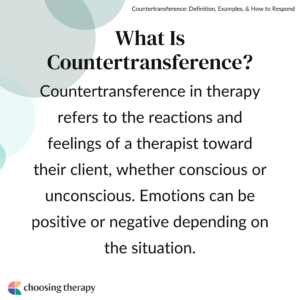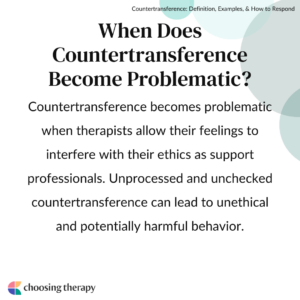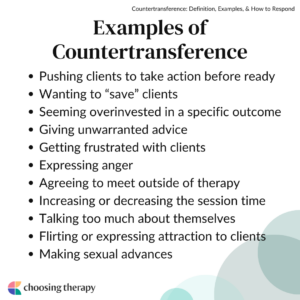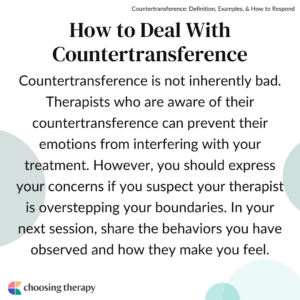Countertransference arises when a therapist experiences an emotional reaction toward a client. Generally, countertransference in therapy does not pose a problem if the therapist is aware of these responses and prevents them from interfering with sessions. However, problematic and potentially harmful behavior can occur with unchecked countertransference.
Find the perfect therapist for you, with BetterHelp. If you don’t click with your first match, you can easily switch therapists. BetterHelp has over 20,000 licensed therapists who provide convenient and affordable online therapy. BetterHelp starts at $65 per week. Take a Free Online Assessment and get matched with the right therapist for you.
What Is Countertransference?
Countertransference in therapy refers to the reactions and feelings of a therapist toward their client, whether conscious or unconscious.(FN1) Emotions can be positive or negative depending on the situation. For example, a therapist may become frustrated over a lack of progress and react by canceling or ending sessions early. In turn, the client feels hurt, dismissed, or abandoned.
In some cases, countertransference can stem from personal past experiences. A therapist may offer advice to “save” a client from a situation they encountered themselves. Countertransference can also occur in response to a behavior, such as crossing boundaries.1
History of Countertransference
Psychologist Sigmund Freud first introduced the concept of countertransference. He described the phenomenon as the unconscious transference of emotions and feelings onto a client in therapy. In modern psychology, therapists can benefit from understanding and addressing their countertransference.2
When Does Countertransference Become Problematic?
Countertransference becomes problematic when therapists allow their feelings to interfere with their ethics as support professionals.3 An example of negative countertransference would be treating a client differently based on personal beliefs or emotions.
Unprocessed and unchecked countertransference can lead to unethical and potentially harmful behavior. One of the worst outcomes of problematic countertransference is when a therapist pursues a romantic or sexual relationship with their client. Therapists have an ethical and legal obligation to protect their clients, meaning they should never engage with clients sexually or inappropriately.4,5
In certain instances, countertransference can be helpful. Countertransference can give therapists a glimpse into how outsiders may feel about their clients when they are aware of their reactions and seek proper supervision, consultation, or individual therapy. Therapists can use this information to help the client understand their effect on others and work toward developing more positive relationships.
Top Rated Online Therapy Services BetterHelp – Best Overall “BetterHelp is an online therapy platform that quickly connects you with a licensed counselor or therapist and earned 4 out of 5 stars.” Visit BetterHelp Talkspace - Best For Insurance Talkspace accepts many insurance plans including Optum, Cigna, and Aetna. Typical co-pay is $30, but often less. Visit Talkspace
Warning Signs of Negative Countertransference
Countertransference in counseling or therapy differs depending on the client, therapist, and situation. Good therapists pay attention to and acknowledge countertransference with their clients, allowing them to prevent their emotions from interfering with treatment. However, specific signs may indicate problematic countertransference, such as poor boundaries and extreme reactions.
Warning signs of countertransference include:
- Failing to maintain healthy boundaries
- Extreme emotional reactions to client behavior
- Inappropriate romantic or sexual behavior
- Inappropriate self-disclosure
Examples of Countertransference
Therapists are required to act ethically and in the best interest of their clients.6 Negative countertransference may manifest as offering unsolicited advice, unchecked frustration, and behavior that oversteps client-therapist boundaries.
For instance, a therapist may unjustly show aggression toward their client or share too many personal details about themselves. While offering some information about their lives is expected, a therapist should avoid overshadowing their clients with their emotions and thoughts.
Common examples of countertransference in therapy include:
- Pushing clients to take action before ready
- Wanting to “save” clients from their problems
- Seeming overinvested in a specific outcome
- Giving unwarranted advice
- Getting frustrated when clients do not take their advice
- Expressing anger in a hostile or aggressive manner
- Agreeing to meet with clients outside of therapy
- Increasing or decreasing the session time beyond what it should be
- Talking too much about themselves in an unhelpful way
- Flirting or expressing attraction to clients
- Making sexual advances
Transference Vs. Countertransference
Transference and countertransference are both common in therapy but differ in various ways. Countertransference occurs when therapists direct their emotions toward clients, while transference is when clients project their feelings about another person onto their therapist.7
An example of transference would be a client re-experiencing feelings of rejection from childhood when their therapist cancels an appointment. They may falsely assume their therapist is operating like their parents and neglecting their needs as a client.
Both countertransference and transference involve projection, and these feelings can affect the client-therapist relationship. Like countertransference, transference can be positive or negative and conscious or unconscious. Therapists can hone in countertransference and transference to help clients understand their patterns and make positive changes.
How to Deal With Countertransference
Countertransference is not inherently bad. Therapists who are aware of their countertransference can prevent their emotions from interfering with your treatment. However, you should express your concerns if you suspect your therapist is overstepping your boundaries. In your next session, share the behaviors you have observed and how they make you feel.
You may even share your own transference reactions. For example, you can say, “I’ve been noticing that you have been doing X lately, and it’s causing me to feel Y.” In many cases, this can provide opportunities to talk about your relationship and work through the dynamics. Openly discussing these behaviors in therapy can not only provide insight into yourself but also show your therapist the need to manage countertransference.
Final Thoughts
Countertransference isn’t necessarily bad but can become problematic when therapists engage in inappropriate behavior or lose the ability to be objective. Remember, therapists are human, too. You can either address these issues together or consider finding a new provider.
Additional Resources
To help our readers take the next step in their mental health journey, Choosing Therapy has partnered with leaders in mental health and wellness. Choosing Therapy is compensated for marketing by the companies included below.
Online Therapy
BetterHelp Get support and guidance from a licensed therapist. BetterHelp has over 20,000 therapists who provide convenient and affordable online therapy. Complete a brief questionnaire and get matched with the right therapist for you. Get Started
Online Psychiatry
Hims / Hers If you’re living with anxiety or depression, finding the right medication match may make all the difference. Connect with a licensed healthcare provider in just 12 – 48 hours. Explore FDA-approved treatment options and get free shipping, if prescribed. No insurance required. Get Started
Reduce Drinking
Sunnyside Want to drink less? Sunnyside helps you ease into mindful drinking at your own pace. Think lifestyle change, not a fad diet. Develop new daily routines, so you maintain your new habits for life. Take a 3 Minute Quiz
Mental Health Newsletter
A free newsletter from Choosing Therapy for those interested in mental health issues and fighting the stigma. Get helpful tips and the latest information. Sign Up
What Is Exposure and Response Prevention Therapy? ERP therapy alters OCD’s pattern by addressing both obsessions and compulsions. In ERP, an individual is encouraged to confront the stimuli that trigger distress related to their obsessions while also resisting the urge to perform compulsions in an attempt to reduce their distress.
Why is ERP So Expensive? There are hundreds of OCD tests and “OCD quizzes” online. Some aim to help people self-diagnose; others turn obsessive-compulsive disorder into a joke. Either way, a vast majority of these are not helpful and probably create more problems than solutions.








